Trees:
A number of aspects of tree management are dealt with here all of which are important to the success of the trees in the silvopastoral agroforestry system.
The first set of links is about getting going, choosing the right tree species and getting the tree seedlings.
The establishment is the phase of planting the trees and getting them growing out of the tree shelters or net guards, this phase can last from one to five years depending on the growth rate of the trees. The next phase, the post-establishment phase, involves more work with the trees to ensure a good timber crop at the end of the day and acceptable levels of livestock production.
Timber trees | Non-timber trees | Site suitability | Planting stock quality | Tree nurseries
Tree establishment | Post-establishment management
Timber trees:
The selection of the timber tree species to plant is critical to the success of a silvopastoral system. They must, in the first place, be able to grow on your site and they must meet your requirements in terms of, for example, timber value and benefits to the environment. Several tree species are suitable for use in silvopastoral agroforestry systems, though not all of them have been tested as agroforestry trees.
Timber tree species:The following characteristics are shown in the Species table (click on the Species table link you will find below when you have read about the information in it).
Potential timber value is important for the financial return when the trees are finally felled. Different tree species produce timber with different qualities resulting in them being suited for different uses. For example, timber which can be used for furniture will have a higher value than timber which can be used as a building material. Tree management, especially pruning, will greatly influence the final quality.
Potential growth rates of trees are the Forestry Commission's yield class (cubic metres of timber grown per hectare per year at full forestry spacings and on an ideal site).
Apical dominance is a desirable characteristic. Trees with strong apical dominance tend to grow with a single stem and a minimum of forking. Forking requires additional pruning to maintain good form.
Light branching is a desirable characteristic. Trees with light branches will have small knots in the timber they produce which generally means better quality timber. Light branches are much easier to prune. Trees with heavy branches will be more difficult to prune and may require to be pruned sooner.
Success in UK trials indicates if the species has been tested in silvopastoral systems in the UK.
Native trees can often be slower growing but they are considered to contribute more to the environment than the faster growing, introduced species.
In the Species table: *** means the best; * means the poorest; minus sign (-) means no information is available.
(The Table was adapted from the Forestry Commission Bulletin 122 Agroforestry in the UK)
| Species | Potential timber value | Potential growth rate | Apical dominance | Light branching | Success in UK trials | Native | Notes Top of page |
|---|---|---|---|---|---|---|---|
| Broadleaves | |||||||
| Alder - grey | ** | 14 | ** | ** | - | no | Alternative to red alder in the north |
| Alder - red | ** | 14 | ** | ** | ** | no | Nitrogen fixer - good for pasture? |
| Ash | *** | 12 | *** | *** | *** | yes | Recommended for lowland systems |
| Beech | ** | 10 | ** | * | - | yes | Good for amenity & environment benefits |
| Oak | ** | 8 | ** | * | - | yes | Good for amenity & environment benefits |
| Poplar | *** | 26 | *** | *** | ** | no | Fast growing, best in lowland systems |
| Sycamore | *** | 12 | *** | ** | *** | no | Recommended for upland systems |
| Wild cherry | *** | 9 | *** | * | ** | yes | Heavy branching at wide spacing |
| Conifers | |||||||
| Hybrid larch | ** | 14 | ** | *** | * | no | Only in very sheltered sites |
| Scots pine | ** | 14 | *** | ** | ** | yes | Good for amenity & environment benefits |
Site suitability:
It is very important to plant the correct species on your site. If a site is unsuitable for a particular tree species it will not grow well in terms of either growth rate or growth form or both, indeed in some cases the tree may not even survive. Tree species must be carefully selected on the basis of the climate and soil quality of the individual site. Advice can be sought from professional forestry advisors, for example through the Institute of Chartered Foresters.
The Forestry Commission's Ecological Site Classification (ESC) is a PC-based decision support system for British Forests and can be used to check the suitability of a given site to a range of tree species - it is not a substitute for professional advice. More information on the ESC is available from the Forestry Commission's ESC website.
The ESC requires data on the specific site to be planted. Climatic factors are based upon the grid reference, the elevation (altitude) and the soil type. From these data the climatic factors (accumulated temperature - AT, moisture deficit - MD, windiness - DAMS and continentality -CON (based on distance from the sea)) are calculated but only an approximate estimate of soil quality (soil moisture regime - SMR and soil nutrient regime - SNR) can be made. The ESC can use additional data provided by the user (e.g. rooting depth, soil texture and stoniness) to make a more precise estimate of SMR. If lithology is know for the site this can be combined with the soil type to provide a more precise estimate of SNR. The ESC can also use knowledge of the semi-natural plant cover to estimate SNR, however, since silvopastoral agroforestry is likey to be adopted on permanent pastures made up of sown species which have been maintained by application of fertilisers, this is not a useful input. In some cases, as a consequence of a history of fertiliser application, the SNR may be higher than base level calculated by the ESC. Adjustments can be made for this difference.
The ESC provides an estimate of site's suitability for a range of tree species and estimates of the yield class of the species: the yield class (cubic metres of timber accumulated per hectare per year) is for planting at the full forestry rate. Some examSples of running the ESC are given below.
Examples of output from the Forestry Commission's Ecological Site Classification.
Northeast Scotland lowland | Northeast Scotland upland | Central Scotland lowland
South Wales upland | Southwest England lowland | Back to site suitability | Top of page
| Northeast Scotland lowland farm - species | |||
|---|---|---|---|
| Soil type | Altitude (m) | Drainage | The Result column shows that the site is suitable for all species except Poplar - it is very suitable for some conifers but these are not considered as agroforestry timber trees. The site is not very suitable for sycamore, for example, because the accumulated temperature (AT) is too low, all other characteristics of the site would make it very suitable. Predicted yields are shown here |
| Non-calcareous gley | 80 | Poor | |
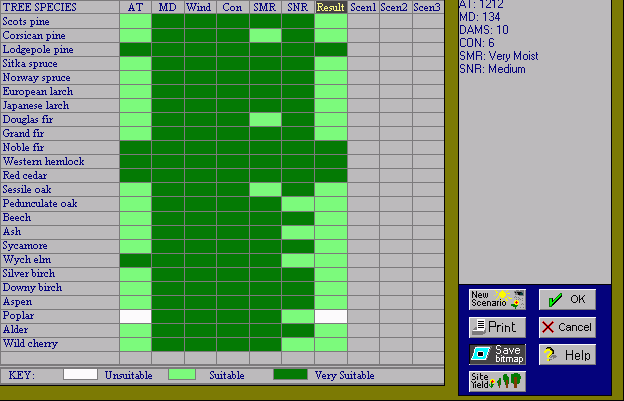 |
Output from Forestry Commission's Ecological Site Classification Back to Ecological Site Classification Back to ESC examples |
| Northeast Scotland lowland farm - site yields | |||
|---|---|---|---|
| Soil type | Altitude (m) | Drainage | The grey boxes show the yield range in GB for each species. Within the range is a blue mark showing the predicted site yield for each species. The predicted yield class and the limiting factor are shown in the two data columns. This table confirms that sycamore and most other species, are limited by AT. Back to species table |
| Non-calcareous gley | 80 | Poor | |
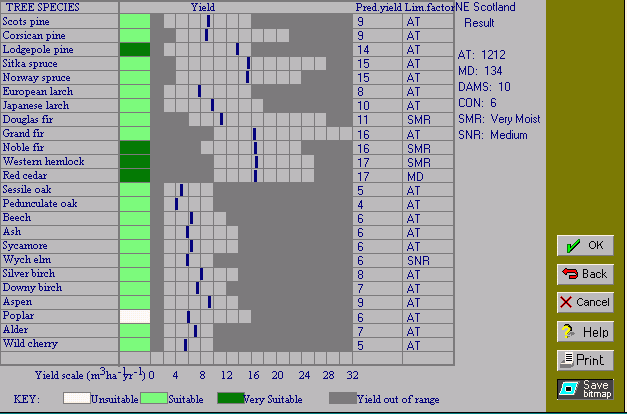 |
Output from Forestry Commission's Ecological Site Classification Back to Ecological Site Classification Back to ESC examples |
| Northeast Scotland upland farm - species | |||
|---|---|---|---|
| Soil type | Altitude (m) | Drainage | The site is suitable for fewer species than the lowland site - it is very suitable for one conifer (not considered for agroforestry timber). Two scenarios were tested, one has SNR poor (the base value: Result column) the other has SNR medium (because of a history of fertiliser application: Scen1 column) but is not different. Predicted yields are shown here |
| Brown forest | 250 | Good | |
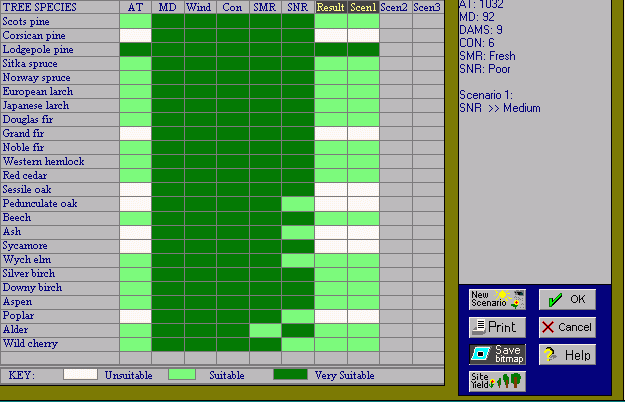 |
Output from Forestry Commission's Ecological Site Classification Back to Ecological Site Classification Back to ESC examples |
| Northeast Scotland upland farm - site yields | |||
|---|---|---|---|
| Soil type | Altitude (m) | Drainage | The grey boxes show the yield range in GB for each species. Within the range is a blue mark showing the predicted site yield for each species. The predicted yield class and the limiting factor are shown in the two data columns. All the species are limited by AT except for one (SMR), so changing SNR had no effect. Back to species table |
| Brown forest | 250 | Good | |
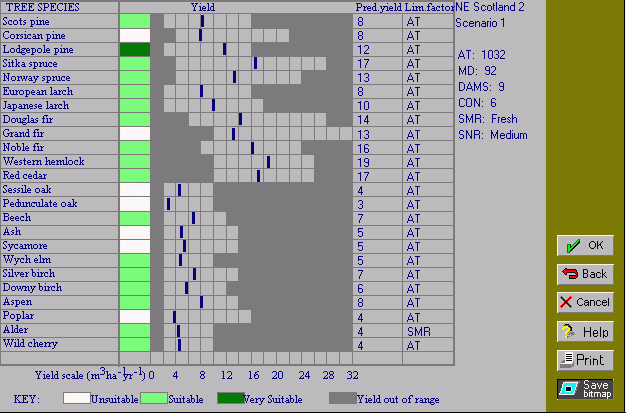 |
Output from Forestry Commission's Ecological Site Classification Back to Ecological Site Classification Back to ESC examples |
| Central Scotland lowland farm - species | |||
|---|---|---|---|
| Soil type | Altitude (m) | Drainage | The Result column shows that the site is suitable for all species - it is very suitable for a range of conifers and some broadleaves. Predicted yields are shown here |
| Brown forest with gleying | 50 | Good | |
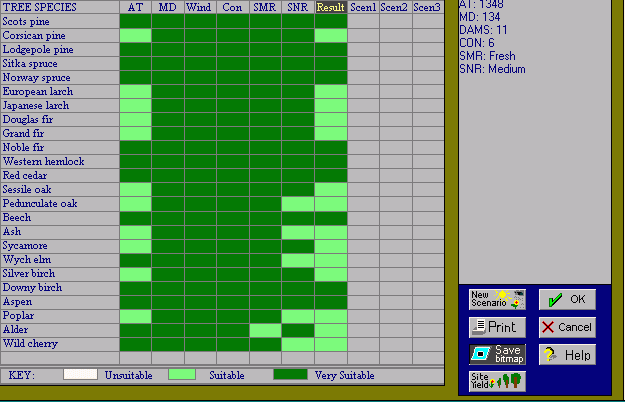 |
Output from Forestry Commission's Ecological Site Classification Back to Ecological Site Classification Back to ESC examples |
| Central Scotland lowland farm - site yields | |||
|---|---|---|---|
| Soil type | Altitude (m) | Drainage | The grey boxes show the yield range in GB for each species. Within the range is a blue mark showing the predicted site yield for each species. The predicted yield class and the limiting factor are shown in the two data columns. The species are limited by a range of factors. Back to species table |
| Brown forest with gleying | 50 | Good | |
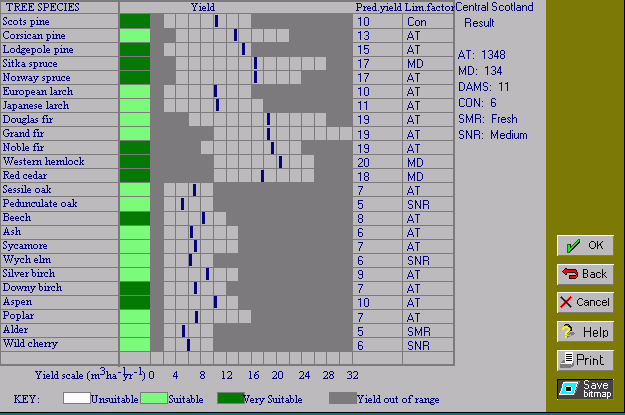 |
Output from Forestry Commission's Ecological Site Classification Back to Ecological Site Classification Back to ESC examples |
| South Wales upland farm - species | |||
|---|---|---|---|
| Soil type | Altitude (m) | Drainage | Two scenarios were run, one with SNR poor (the base value: Result column) and one with SNR medium (because of a history of fertiliser application: Scen1 column). With SNR poor, the site is unsuitable for some species. With SNR medium, the site is at least suitable for all species. Predicted yields are shown here |
| Brown forest | 330 | Good | |
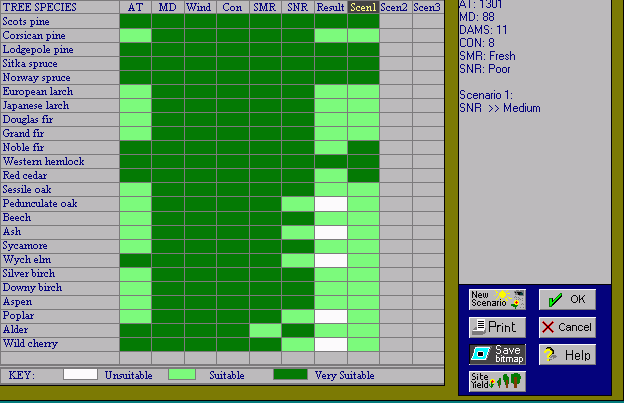 |
Output from Forestry Commission's Ecological Site Classification Back to Ecological Site Classification Back to ESC examples |
| South Wales upland farm - site yields | |||
|---|---|---|---|
| Soil type | Altitude (m) | Drainage | The grey boxes show the yield range in GB for each species. Within the range is a blue mark showing the predicted site yield for each species. The predicted yield class, with SNR medium, and the limiting factor are shown in the two data columns. The species are mainly limited by AT. Back to species table |
| Brown forest | 330 | Good | |
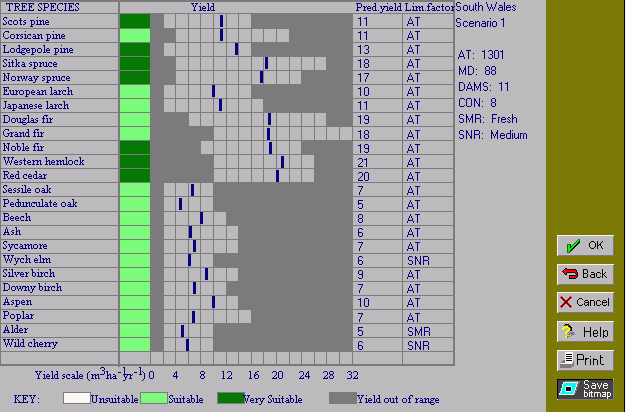 |
Output from Forestry Commission's Ecological Site Classification Back to Ecological Site Classification Back to ESC examples |
| Southwest England lowland farm - species | |||
|---|---|---|---|
| Soil type | Altitude (m) | Drainage | Two scenarios were run, one with SNR very rich (the base value: Result column) and one with SNR medium (because it is a pasture site: Scen1 column). With SNR very rich, the site is unsuitable for 10 species. With SNR medium, the site is unsuitable for only six species. SMR is limiting in most of the six cases. Predicted yields are shown here |
| Shallow surface-water gley | 180 | Poor | |
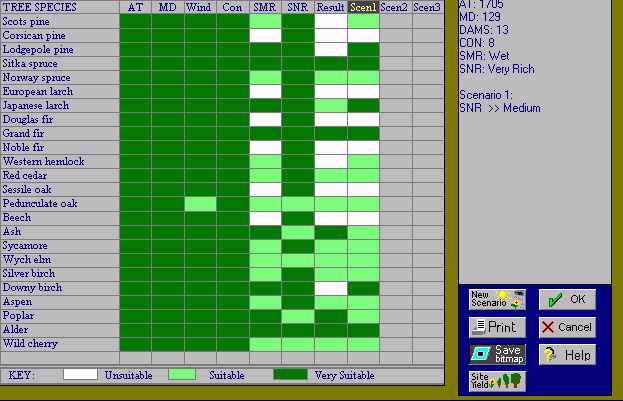 |
Output from Forestry Commission's Ecological Site Classification Back to Ecological Site Classification Back to ESC examples |
| Southwest England lowland farm - site yields | |||
|---|---|---|---|
| Soil type | Altitude (m) | Drainage | The grey boxes show the yield range in GB for each species. Within the range is a blue mark showing the predicted site yield for each species. The predicted yield class, with SNR medium, and the limiting factor are shown in the two data columns. The species are mainly limited by SMR. Back to species table |
| Shallow surface-water gley | 180 | Poor | |
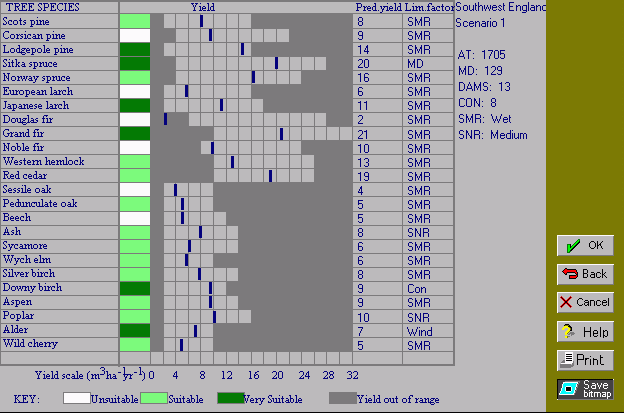 |
Output from Forestry Commission's Ecological Site Classification Back to Ecological Site Classification Back to ESC examples |
Planting stock quality
The choice of planting stock is important, planting a relatively small number of trees at wide spacing means that the highest possible percentage of trees must establish and grow well, so planting stock quality must be good. It is also important to get planting stock without too much variability so that all of the trees establish and grow at similar rates.
Planting for broadleaves (other than poplar) and conifers will be rooted, usually one- or two-year old transplants. For silvopastoral agroforestry systems in which tree shelters or tree guards are being used, the plants will probably be bare rooted and can be in the height range 20 cm to 30 cm. Container (pot or cell) grown plants are often taller and invariably more expensive than bare-rooted plants but the extra expense might be justified when small numbers of trees are being planted. If fenced enclosures are to be used the bare-rooted plants could be taller, for example, in the range 30 cm to 90 cm.
Poplars, unlike the other broadleaves, can produce roots from young dormant shoots when they are inserted into the ground.Most of the commercially available poplars can be propagated in this way from one-year-old wood. Most nurseries will provide unrooted planting material in preference to rooted plants. The unrooted sets or cuttings which are supplied by the nursery are planted by sticking them into the soil having previously cultivated the planting area, more details are supplied in the establishment section of this web site.
Because relatively few trees are planted on farms, when compared to commercial forestry, research has been carried out to select "elite" trees which will show vigorous growth and be much more even in their development and growth than the seed-grown trees normally provided by nurseries. Information on clonal material is available here.
There are many nurseries which can supply planting stock of the tree species suitable for silvopastoral agroforestry. Information on nurseries is available here.

